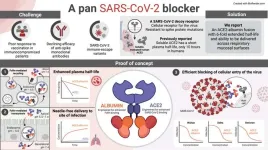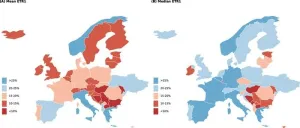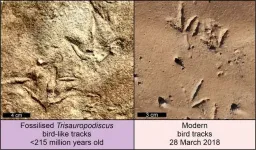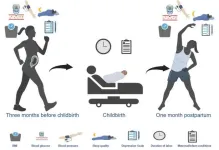(Press-News.org) We tend to think of large cities as melting pots – places where people from all sorts of backgrounds can mingle and interact. But according to new research, people in big cities tend to primarily interact with other individuals in the same socioeconomic bracket, whereas people in small cities and rural areas are much more likely to have diverse interactions.
Using cellphone data, a collaboration of researchers led by Stanford University determined that most people in big cities have very few opportunities for even brief interactions with those outside their own socioeconomic status. The results, published Nov. 29 in Nature, show that if we want cities to be the cosmopolitan mixing grounds we expect them to be, we need to make intentional urban design choices to encourage those interactions.
“As we become an ever more urban country, it’s important to figure out whether big cities are living up to the long-standing assumption that they promote mixing and diversity,” said David Grusky, the Edward Ames Edmonds Professor in the School of Humanities and Sciences. “Although income inequality remains extremely high, that doesn’t mean that we also have to reconcile ourselves to highly segregated cities in which people who are rich never see or interact with those who are poor.”
Few opportunities to meet
The researchers used GPS data collected in 2017 from 9.6 million cellphones across 382 metropolitan areas in the United States to determine how often people of different socioeconomic statuses crossed paths during the day – essentially how many times people had the opportunity to interact, even briefly, with someone in a different income bracket.
After inferring each person’s socioeconomic status from estimated rental prices on a real estate marketing website, the researchers counted potential interactions between users over the course of the day – times where two cellphones had GPS pings within 50 meters of each other within a five-minute window. They collected data on almost 1.6 billion path-crossings.
This large amount of extremely precise data allowed the researchers to see a clear pattern that has been missed by similar studies in the past: large cities fostered socioeconomic segregation. People living in the 10 most populous metropolitan areas, which include cities like New York City, Los Angeles, and Chicago, along with their surrounding areas, were significantly less likely to interact with people of different socioeconomic statuses than people in metropolitan areas with fewer than 100,000 residents.
“That seems like a counterintuitive observation,” said Jure Leskovec, a professor of computer science. “But there is a large variety of choices in big cities. In New York, you can spend $10 on a dinner or $1,000 on a dinner, whereas if you live in a place with only one diner, everyone goes there, rich or poor. That seems to be the main mechanism for this phenomenon.”
Designs that bridge neighborhoods
The good news is, there are ways to build cities to foster more socioeconomic mixing. Looking at large cities, the researchers found that those that placed frequently-visited hubs in between different neighborhoods – instead of in the center of each neighborhood – were less segregated.
“These big cities have managed to foster diverse interactions because the hubs that people visit the most – which turn out to be shopping malls, plazas, and similar places – are between rich and poor neighborhoods,” said Hamed Nilforoshan, a doctoral student in Leskovec’s lab and first author on the paper. “Those hubs act as bridges, allowing people to see each other and interact.”
By providing a better understanding of how the location of public infrastructure can affect socioeconomic mixing, the researchers hope their work will assist urban planners in building cities that live up to the promise of fostering diverse interactions. Cities are constantly being rebuilt and redesigned, and this work could help ensure that those changes benefit everyone.
“We’ve long emphasized residential integration – and we’re right to do so – but we now have a complementary way to mitigate socioeconomic segregation,” Grusky said. “When new shopping centers and other activity hubs are up for approval, we need to make sure they’re located in places that will promote diversity, not segregation.”
Grusky is the director of the Stanford Center on Poverty and Inequality; a senior fellow at the Stanford Institute for Economic Policy Research; and a faculty affiliate of the Stanford Institute for Human-Centered Artificial Intelligence.
Leskovec is a member of Stanford Bio-X and the Wu Tsai Neurosciences Institute; and a faculty affiliate of the Stanford Institute for Human-Centered Artificial Intelligence.
Other Stanford co-authors of this research include research assistants Wenli Looi, Blanca Villanueva, Nic Fishman, Yiling Chen, and John Sholar. Other coauthors are from Cornell Tech and Northwestern University.
This work was funded by the Defense Advanced Research Projects Agency, the Army Research Office, the National Science Foundation, the National Institutes of Health, Stanford Data Science Initiative, Wu Tsai Neurosciences Institute, Amazon, Docomo, GSK, Hitachi, Intel, JPMorgan Chase, Juniper Networks, KDDI, NEC, and Toshiba.
END
Big cities foster socioeconomic segregation; Here’s how we can fix that
Cellphone data show that most people in big cities do not interact with others outside their own socioeconomic bracket, but locating meeting places between neighborhoods could help change that
2023-11-29
ELSE PRESS RELEASES FROM THIS DATE:
A long-acting biologic with transmucosal transport properties that arrest SARS-CoV-2 virus variants
2023-11-29
When the COVID-19 pandemic first started, no effective anti-viral drugs were available to fight the disease. However, in record time, so-called monoclonal antibodies were developed as a lifesaving treatment. Now, 3 years later, none of the approved antibodies work effectively against the new SARS-CoV-2 virus variants due to mutations that alter their spike protein.
While vaccines protect against severe disease, there is still an urgent need for effective virus-blocking agents for therapeutic or prophylactic use. This is particularly relevant for patients ...
Study reveals the real tax rate paid by multinational corporations in 47 countries
2023-11-29
Despite a similar statutory tax rate for multinational corporations (MNCs) across many countries, the effective tax rate that MNCs actually pay differs greatly — as low as 1% of gross income in Luxembourg and as high as 67% in Norway. That’s one conclusion of a study published this week in the open-access journal PLOS ONE by Javier Garcia-Bernardo of Utrecht University, the Netherlands, Petr Janský of Charles University, Czechia, and Thomas Tørsløv of Danmarks Nationalbank, Denmark. The study comes on the ...
Unknown animals were leaving bird-like footprints in Late Triassic Southern Africa
2023-11-29
Ancient animals were walking around on bird-like feet over 210 million years ago, according to a study published November 29, 2023 in the open-access journal PLOS ONE by Miengah Abrahams and Emese M. Bordy of the University of Cape Town, South Africa.
Numerous fossil sites in southern Africa preserve distinctive three-toed footprints that have been named Trisauropodiscus. For many years, researchers have debated what animals might have left these tracks, as well as precisely how many different species (technically called ichnospecies) of Trisauropodiscus there are.
In this study, the researchers reassessed the ...
Exercise may reduce postpartum depression, with moderate intensity exercises three to four times a week being especially effective, per meta-analysis
2023-11-29
Exercise may reduce postpartum depression, with moderate intensity exercises three to four times a week being especially effective, per meta-analysis
###
Article URL: https://journals.plos.org/plosone/article?id=10.1371/journal.pone.0287650
Article Title: Effectiveness of aerobic exercise in the prevention and treatment of postpartum depression: Meta-analysis and network meta-analysis
Author Countries: China
Funding: This work was financially supported by the Fundamental Research Funds for the Central Universities in China (Grant no. CUG150607). The funders did not play a role ...
Breaking down barriers: What happens when the vaginal microbiome attacks
2023-11-29
Bacterial vaginosis is a common condition in which the natural microbiome of the vagina falls out of balance, sometimes leading to complications in sexual and reproductive health. But exactly how these bacterial populations disrupt vaginal health has remained unclear.
Researchers at University of California San Diego School of Medicine have now found that in bacterial vaginosis, certain bacterial species dismantle protective molecules on the surface of the cells lining the vagina, dysregulating key processes that mediate cell turnover, death and response to surrounding bacteria.
The findings, published November 29, 2023 in Science Translational Medicine, may help explain why bacterial ...
Being prepared for storm surges on the Baltic Sea coast
2023-11-29
The record storm surge in October 2023 caused severe damage to the German Baltic coast. Effective adaptation scenarios to rising sea levels are therefore becoming increasingly urgent. In two recent studies, researchers at Kiel University have modelled both the flooding extent along the Baltic Sea coastal areas and, for the first time, two possible upgrades for current dike lines in high resolution. They modelled various storm surge and sea level rise scenarios. Their results show that, based on the current dike line, neither an increase ...
Findings challenge standard understanding of COVID-19 infection
2023-11-29
RIVERSIDE, Calif. -- Some viruses move between species. For example, SARS-CoV-2, the virus that causes COVID-19, can spill over from humans to mink, an agricultural species, and then spill back from mink to humans. Spill back is a concern because SARS-CoV-2 can mutate in the mink and come back to humans in a more virulent form. Both spill over and spill back of SARS-CoV-2 have been reported on mink farms in the United States and Europe.
To address these issues, a research team at the University of California, Riverside, has ...
Building the digital replica of our seas: an open call for crucial biodiversity data to restore ocean ecosystems
2023-11-29
The Horizon Europe DTO-BioFlow project (https://dto-bioflow.eu) has launched an Open Call offering up to 60,000€ for institutions that manage marine biodiversity data, to invite them to contribute to the European Digital Twin of the Ocean (EU DTO) by making these data available to the public domain through EMODnet Biology, the portal that provides open and free access to interoperable data and data products on temporal and spatial distribution of marine species (angiosperms, benthos, birds, fish, macroalgae, mammals, reptiles, phyto- and zooplankton) from European regional seas. Published officially on Tuesday, October 31st, this single-stage call is open to a wide ...
New research sheds light on Bantu-speaking populations' expansion in Africa
2023-11-29
About 350 million people across Africa speak one or more of the 500 Bantu languages. New genetic analysis of modern and ancient individuals suggests that these populations probably originated in western Africa and then moved south and east in several waves. The study has been published in the scientific journal Nature.
The expansion of people speaking Bantu languages is considered one of the most dramatic demographic events in Late Holocene Africa, which began 6,000 to 4,000 years ago in western Africa. This new study generated and analysed a comprehensive dataset, including genomic data of modern-day populations from 1,763 participants ...
Popularity matters more than compatibility on dating apps
2023-11-29
A new study has found that algorithms used by online dating platforms have popularity bias - meaning that they recommend more popular, attractive users over less popular, less attractive users. Researchers at Carnegie Mellon University and the University of Washington published their findings in Manufacturing & Service Operations Management.
They evaluated data from over 240,000 users of a major online dating platform in Asia over three months. They found that a user's chance of being recommended by the platform's algorithm ...
LAST 30 PRESS RELEASES:
Making lighter work of calculating fluid and heat flow
Normalizing blood sugar can halve heart attack risk
Lowering blood sugar cuts heart attack risk in people with prediabetes
Study links genetic variants to risk of blinding eye disease in premature infants
Non-opioid ‘pain sponge’ therapy halts cartilage degeneration and relieves chronic pain
AI can pick up cultural values by mimicking how kids learn
China’s ecological redlines offer fast track to 30 x 30 global conservation goal
Invisible indoor threats: emerging household contaminants and their growing risks to human health
Adding antibody treatment to chemo boosts outcomes for children with rare cancer
Germline pathogenic variants among women without a history of breast cancer
Tanning beds triple melanoma risk, potentially causing broad DNA damage
Unique bond identified as key to viral infection speed
Indoor tanning makes youthful skin much older on a genetic level
Mouse model sheds new light on the causes and potential solutions to human GI problems linked to muscular dystrophy
The Journal of Nuclear Medicine ahead-of-print tip sheet: December 12, 2025
Smarter tools for peering into the microscopic world
Applications open for funding to conduct research in the Kinsey Institute archives
Global measure underestimates the severity of food insecurity
Child survivors of critical illness are missing out on timely follow up care
Risk-based vs annual breast cancer screening / the WISDOM randomized clinical trial
University of Toronto launches Electric Vehicle Innovation Ontario to accelerate advanced EV technologies and build Canada’s innovation advantage
Early relapse predicts poor outcomes in aggressive blood cancer
American College of Lifestyle Medicine applauds two CMS models aligned with lifestyle medicine practice and reimbursement
Clinical trial finds cannabis use not a barrier to quitting nicotine vaping
Supplemental nutrition assistance program policies and food insecurity
Switching immune cells to “night mode” could limit damage after a heart attack, study suggests
URI-based Global RIghts Project report spotlights continued troubling trends in worldwide inhumane treatment
Neutrophils are less aggressive at night, explaining why nighttime heart attacks cause less damage than daytime events
Menopausal hormone therapy may not pose breast cancer risk for women with BRCA mutations
Mobile health tool may improve quality of life for adolescent and young adult breast cancer survivors
[Press-News.org] Big cities foster socioeconomic segregation; Here’s how we can fix thatCellphone data show that most people in big cities do not interact with others outside their own socioeconomic bracket, but locating meeting places between neighborhoods could help change that








